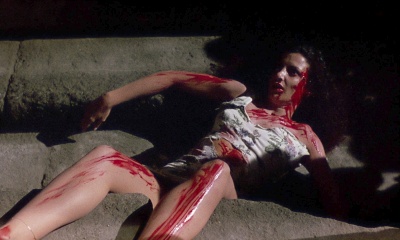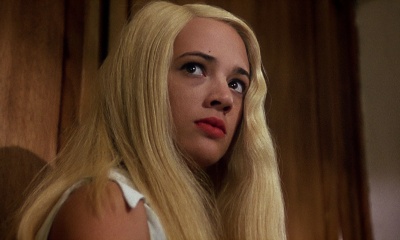| Reviews & Columns |
|
Reviews DVD TV on DVD Blu-ray 4K UHD International DVDs In Theaters Reviews by Studio Video Games Features Collector Series DVDs Easter Egg Database Interviews DVD Talk Radio Feature Articles Columns Anime Talk DVD Savant Horror DVDs The M.O.D. Squad Art House HD Talk Silent DVD
|
DVD Talk Forum |
|
|
| Resources |
|
DVD Price Search Customer Service #'s RCE Info Links |
|
Columns
|
|
|
Stendhal Syndrome, The
Blue Underground // Unrated // November 18, 2008
List Price: $34.95 [Buy now and save at Amazon]
Florence
is the birthplace of the Stendhal syndrome: a sense of being psychologically overwhelmed when in the presence of great works of art. It's in this legendarily beautiful city that Detective Anna Manni (Asia Argento) has followed a murderous rapist that's carved a path of terror throughout Italy. Anna skulks the halls of the Uffizi Gallery in search of the killer when she's overcome by the power of the art around her, falling to the floor. These paintings inspire a surreal dream, but what she awakes to is an unrelenting nightmare: the seemingly kind fellow in the museum that lends her a hand is the killer (Thomas Kretschmann), and he rapes, tortures, and degrades Anna until her mind is left in bloodied tatters. Anna is left alive but is colder, more violent, and tormented by the spectre of Alfredo returning to finish the job.
The Stendhal Syndrome steps away from the traditional giallo formula. There's no need for masks or black leather gloves this time around -- the identity of the killer is never in question -- and Argento is less fascinated by elaborate, operatic murders than he has been in years past. The body count is low, but this is by design; The Stendhal Syndrome is ultimately about the torment being inflicted on Anna and how ravaged she is by these attacks. Argento is daring enough to structure the film far away from convention, creating what amounts to a two-act story that caught me off-guard my first time through.
There's a rawness and savagery to these attacks that are far removed from Argento's trademark operatic flair. The rapes and murders aren't elaborately staged, bathed in candy-colored lighting, or set against blaring rock music. The movie doesn't
revel in explicit gore, really, but the assaults are cruel and brutal just the same; with as frequently as Argento is compared to Hitchcock, think of the attacks in The Stendhal Syndrome as his Frenzy. They're intense, disturbing, and unflinchingly realistic in a way rarely seen throughout his earlier work. Argento strikes an astonishing balance between the grueling, disturbing attacks and his dreamlike visual mastery. Artwork shuffles to life, a disoriented Anna dreams of deformed fish, and the detective steps through gateways of paintings. It's impressive enough that Argento considers it to be the most visually striking of his movies. The film also closes with one of the most magnificent final shots of Argento's career. The Stendhal Syndrome marks the first collaboration between Argento and the legendary Ennio Morricone since Four Flies on Grey Velvet twenty-five years earlier, and so much of the effectiveness of the film is owed to Morricone's beautifully haunting score.
There are very few faults to be found throughout The Stendhal Syndrome. One misstep doesn't date back to the original photography, though. The movie was filmed with the expectation that its dialogue would be re-recorded after the fact, and the actors brought in to record the English soundtrack are wooden, stilted, and extremely unconvincing. The Italian recording isn't perfect either, but it makes for a considerably more engaging experience, and I'd recommend that over any of the three English tracks on this Blu-ray disc. The Stendhal Syndrome was the first Italian feature film to make use of digital effects, but its stabs at CGI wouldn't have been convincing back in 1996 and look especially ridiculous now. This is Argento, though, so it goes without saying that the effects are ambitious: a bullet slowly piercing the cheek of one of the maniac's victims, the camera following two pills Anna swallows as they course through her body, and that dreamlike imagery of Anna stepping through paintings. These sorts of effects are used sparingly and are only a brief distraction. My only real disappointment is with the uneven pace, particularly throughout the second half of the film. With tighter editing and a more competent English dub, The Stendhal Syndrome might be much better appreciated than it is now.
Rather than retreat to familiar territory on his return to Italy, Dario Argento decided instead to craft a bleak, somber, and experimental thriller. This is the closest Argento has come to making a character piece, and this series of risks resulted in perhaps his strongest work of the 1990s. I wouldn't recommend The Stendhal Syndrome as a starting point for the uninitiated, but this is a movie well worth discovering on Blu-ray for established fans of the director, and those who've already picked up earlier DVDs ought to consider giving the film another look in high definition. Recommended.
Video
This Blu-ray disc features
some of the most beautifully reproduced film grain I've seen in high definition; out of the hundreds of HD DVDs and Blu-ray discs I've devoured over the past couple of years, only Sony's The Counterfeiters may be in this same league. Each and every granule seems clear and distinct, and the high bitrate of this AVC encode preserves its texture without ever showing any signs of strain. While the screen captures scattered throughout this review have admittedly been recompressed for the web and don't fully do The Stendhal Syndrome justice, open the full-sized versions to get at least some sense of just how wonderfully the film's photography is presented on Blu-ray.
Although the clarity and detail within this lightly pillarboxed 1.66:1 image aren't especially dazzling, the flawless reproduction of the film grain suggests this is a limitation of the original photography. It's still a noticeable improvement over previous releases, and Argento fans who've only been exposed to the borderline-unwatchable DVD released by Troma years ago ought to be floored by The Stendhal Syndrome in high definition. Black levels are consistently robust throughout, its palette is less stylized than Argento's best known work but reflects the stark reality of so much of the movie, and the transfer is free of any flaws or wear worth noting.
There's no trace of any sort of visual processing at all: I couldn't spot edge enhancement anywhere throughout, and the consistently grainy texture never shows any sign of being smeared away by heavy-handed noise reduction. This isn't conventional home theater eye candy by any stretch, but I've been very impressed by the work Blue Underground has invested into their first couple of Blu-ray releases, and Argento's legions of fans ought to be pleased with how faithfully the original photography has been reproduced in high definition.
Audio
The Stendhal Syndrome features a slew of different audio options: 7.1 lossless soundtracks in both Dolby TrueHD and DTS-HD Master Audio as well as Dolby Digital 5.1 (448Kbps) tracks in English and Italian. This is a particularly immersive remix, with an unrelenting sense of atmosphere, devastating nightmares, and Ennio Morricone's haunting score swirling from every direction. The English dialogue was re-recorded after the fact, and although it does sound canned and unconvincing, it's technically reproduced well enough. A noticeable hiss lurks in the background, but it's not heavy enough to distract. The lower frequencies are modest, and effects aren't especially full-bodied, but it's still a strong effort. I have to admit that rather than have a pair of lossless English soundtracks, it would've been nice to see Blue Underground offer one in English and another in Italian. Even though the Italian dialogue was looped in post as well, there's an intensity to it that better suits the tone of The Stendhal Syndrome.
Optional English subtitles have also been provided. Because some of the scenes in this unrated cut of The Stendhal Syndrome were never dubbed into English, brief portions of the film are in Italian only and are subtitled.
Extras
The Stendhal Syndrome carries over the feature-length series of retrospective interviews from Blue Underground's two-disc DVD set. All of its extras are presented in standard definition, and these Italian interviews are accompanied by English subtitles.
The Final Word
The Stendhal Syndrome melds Dario Argento's dreamlike imagery with an intense, visceral, and disturbingly realistic brutality, making for one of the director's strongest thrillers of his later period. It's not a perfect movie, no; the early stabs at CGI haven't aged well at all, the poorly looped English dialogue can be distracting, and its slower pace saps away some of the intensity. Still, I'd reach for The Stendhal Syndrome over any of the films that Argento has helmed since Opera, and it's an underappreciated thriller that the director's fans ought to find worth rediscovering on Blu-ray. Recommended.
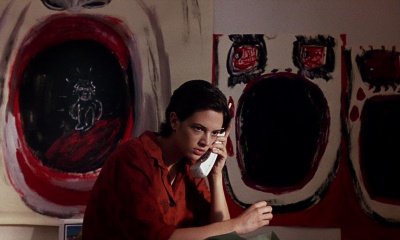 |
| [click on the thumbnail to enlarge] |
The Stendhal Syndrome steps away from the traditional giallo formula. There's no need for masks or black leather gloves this time around -- the identity of the killer is never in question -- and Argento is less fascinated by elaborate, operatic murders than he has been in years past. The body count is low, but this is by design; The Stendhal Syndrome is ultimately about the torment being inflicted on Anna and how ravaged she is by these attacks. Argento is daring enough to structure the film far away from convention, creating what amounts to a two-act story that caught me off-guard my first time through.
There's a rawness and savagery to these attacks that are far removed from Argento's trademark operatic flair. The rapes and murders aren't elaborately staged, bathed in candy-colored lighting, or set against blaring rock music. The movie doesn't
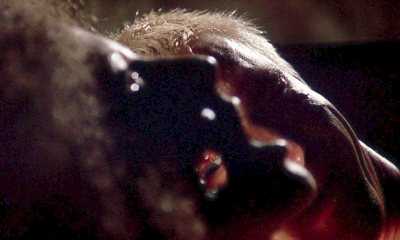 |
| [click on the thumbnail to enlarge] |
There are very few faults to be found throughout The Stendhal Syndrome. One misstep doesn't date back to the original photography, though. The movie was filmed with the expectation that its dialogue would be re-recorded after the fact, and the actors brought in to record the English soundtrack are wooden, stilted, and extremely unconvincing. The Italian recording isn't perfect either, but it makes for a considerably more engaging experience, and I'd recommend that over any of the three English tracks on this Blu-ray disc. The Stendhal Syndrome was the first Italian feature film to make use of digital effects, but its stabs at CGI wouldn't have been convincing back in 1996 and look especially ridiculous now. This is Argento, though, so it goes without saying that the effects are ambitious: a bullet slowly piercing the cheek of one of the maniac's victims, the camera following two pills Anna swallows as they course through her body, and that dreamlike imagery of Anna stepping through paintings. These sorts of effects are used sparingly and are only a brief distraction. My only real disappointment is with the uneven pace, particularly throughout the second half of the film. With tighter editing and a more competent English dub, The Stendhal Syndrome might be much better appreciated than it is now.
Rather than retreat to familiar territory on his return to Italy, Dario Argento decided instead to craft a bleak, somber, and experimental thriller. This is the closest Argento has come to making a character piece, and this series of risks resulted in perhaps his strongest work of the 1990s. I wouldn't recommend The Stendhal Syndrome as a starting point for the uninitiated, but this is a movie well worth discovering on Blu-ray for established fans of the director, and those who've already picked up earlier DVDs ought to consider giving the film another look in high definition. Recommended.
Video
This Blu-ray disc features
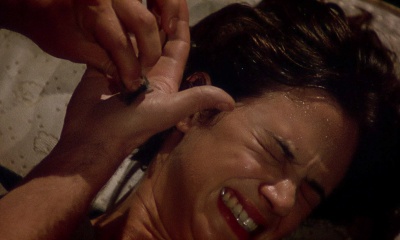 |
| [click on the thumbnail to enlarge] |
Although the clarity and detail within this lightly pillarboxed 1.66:1 image aren't especially dazzling, the flawless reproduction of the film grain suggests this is a limitation of the original photography. It's still a noticeable improvement over previous releases, and Argento fans who've only been exposed to the borderline-unwatchable DVD released by Troma years ago ought to be floored by The Stendhal Syndrome in high definition. Black levels are consistently robust throughout, its palette is less stylized than Argento's best known work but reflects the stark reality of so much of the movie, and the transfer is free of any flaws or wear worth noting.
There's no trace of any sort of visual processing at all: I couldn't spot edge enhancement anywhere throughout, and the consistently grainy texture never shows any sign of being smeared away by heavy-handed noise reduction. This isn't conventional home theater eye candy by any stretch, but I've been very impressed by the work Blue Underground has invested into their first couple of Blu-ray releases, and Argento's legions of fans ought to be pleased with how faithfully the original photography has been reproduced in high definition.
Audio
The Stendhal Syndrome features a slew of different audio options: 7.1 lossless soundtracks in both Dolby TrueHD and DTS-HD Master Audio as well as Dolby Digital 5.1 (448Kbps) tracks in English and Italian. This is a particularly immersive remix, with an unrelenting sense of atmosphere, devastating nightmares, and Ennio Morricone's haunting score swirling from every direction. The English dialogue was re-recorded after the fact, and although it does sound canned and unconvincing, it's technically reproduced well enough. A noticeable hiss lurks in the background, but it's not heavy enough to distract. The lower frequencies are modest, and effects aren't especially full-bodied, but it's still a strong effort. I have to admit that rather than have a pair of lossless English soundtracks, it would've been nice to see Blue Underground offer one in English and another in Italian. Even though the Italian dialogue was looped in post as well, there's an intensity to it that better suits the tone of The Stendhal Syndrome.
Optional English subtitles have also been provided. Because some of the scenes in this unrated cut of The Stendhal Syndrome were never dubbed into English, brief portions of the film are in Italian only and are subtitled.
Extras
The Stendhal Syndrome carries over the feature-length series of retrospective interviews from Blue Underground's two-disc DVD set. All of its extras are presented in standard definition, and these Italian interviews are accompanied by English subtitles.
- Director: Dario Argento (20 min.): This interview opens as Argento discusses how he first came across the concept of the Stendhal syndrome while casting Trauma in New York, and from there, the director delves both into the real-life condition as well as the research that went into translating it to the screen. He speaks at length about his collaboration with much of the talent on both sides of the camera, particularly shooting such a brutal, grueling movie with his own daughter in the lead. Asia herself is briefly featured in a vintage interview as well. Other topics include reuniting with Ennio Morricone for the first time since the Animal Trilogy came to a close a quarter-century earlier and how unnerving it could be to scour the halls of the Uffizi Gallery in the dead of night.
- Inspiration: Psychological Consultant Graziella Magherini (20 min.): The psychologist who first coined the term "Stendhal Syndrome" spends much of this interview describing the condition and discussing several of the cases she's encountered over the years. Magherini also briefly discusses her involvement in helping to shape Argento's film and notes how it led to the formation of the International Association for Art and Psychology.
- Special Effects: Sergio Stivaletti (16 min.): Longtime Argento collaborator Sergio Stivaletti delves into The Stendhal Syndrome's extensive effects work, discussing more traditional, practical effects as well as digital effects that may be rough-hewn but marked a first for Italian cinema. Most of the key sequences are covered, including Anna's surreal encounter with the man-fish, a bullet piercing through a cheek, and the camera digitally following a pair of pills as they're swallowed.
- Assistant Director: Luigi Cozzi (22 min.): Another mainstay on Argento's films, Cozzi devotes much of his interview to discussing working closely by the director's side ever since interviewing him back in 1970, touching on the many, many movies they've made together. The Stendhal Syndrome is addressed only briefly, but Cozzi notes its transition from an American movie with marquee draws in the lead to an Italian production along with his work as second unit director. Cozzi also mentions his role in running Profondo Rosso in Rome as well as the death of the giallo in Italy.
- Production Designer: Massimo Antonello Geleng (23 min.): The designer tasked with bringing Argento's dark dreams to life speaks at length about some of the most memorable backdrops in the film, including a silhouette against a museum draped in darkness and the graffiti-stained home of the maniac. Geleng also tackles quite a few of the other movies he's worked on -- Orca: The Killer Whale, John Guillermin's remake of King Kong, Cannibal Holocaust, City of the Living Dead, Contamination, Mountain of the Cannibal God, and 2019: After the Fall of New York. He has a pretty good sense of humor about quite a few of these, laughing them off as unwatchable, schlocky knockoffs.
- Trailer (1 min.): An English theatrical trailer rounds out the extras.
The Final Word
The Stendhal Syndrome melds Dario Argento's dreamlike imagery with an intense, visceral, and disturbingly realistic brutality, making for one of the director's strongest thrillers of his later period. It's not a perfect movie, no; the early stabs at CGI haven't aged well at all, the poorly looped English dialogue can be distracting, and its slower pace saps away some of the intensity. Still, I'd reach for The Stendhal Syndrome over any of the films that Argento has helmed since Opera, and it's an underappreciated thriller that the director's fans ought to find worth rediscovering on Blu-ray. Recommended.
|
| Popular Reviews |
| Sponsored Links |
|
|
| Sponsored Links |
|
|
| Release List | Reviews | Shop | Newsletter | Forum | DVD Giveaways | Blu-Ray | Advertise |
|
Copyright 2024 DVDTalk.com All Rights Reserved. Legal Info, Privacy Policy, Terms of Use,
Manage Preferences,
Your Privacy Choices | |||||||









